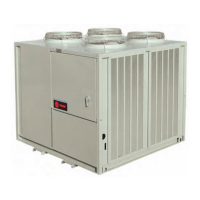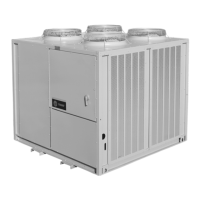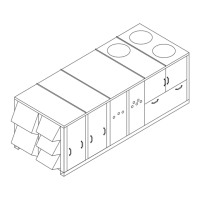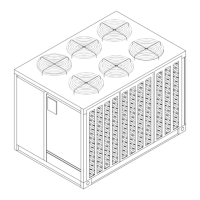36
CAUJ-SVX01E-EN
WWAARRNNIINNGG
HHaazzaarrdd ooff EExxpplloossiioonn!!
FFaaiilluurree ttoo ffoollllooww tthheessee rreeccoommmmeennddaattiioonnss ccoouulldd
rreessuulltt iinn ddeeaatthh oorr sseerriioouuss iinnjjuurryy oorr eeqquuiippmmeenntt oorr
pprrooppeerrttyy--oonnllyy ddaammaaggee..
UUssee oonnllyy ddrryy nniittrrooggeenn wwiitthh aa pprreessssuurree rreegguullaattoorr ffoorr
pprreessssuurriizziinngg uunniitt.. DDoo nnoott uussee aacceettyylleennee,, ooxxyyggeenn oorr
ccoommpprreesssseedd aaiirr oorr mmiixxttuurreess ccoonnttaaiinniinngg tthheemm ffoorr
pprreessssuurree tteessttiinngg.. DDoo nnoott uussee mmiixxttuurreess ooff aa
hhyyddrrooggeenn ccoonnttaaiinniinngg rreeffrriiggeerraanntt aanndd aaiirr aabboovvee
aattmmoosspphheerriicc pprreessssuurree ffoorr pprreessssuurree tteessttiinngg aass tthheeyy
mmaayy bbeeccoommee ffllaammmmaabbllee aanndd ccoouulldd rreessuulltt iinn aann
eexxpplloossiioonn.. RReeffrriiggeerraanntt,, wwhheenn uusseedd aass aa ttrraaccee ggaass
sshhoouulldd oonnllyy bbee mmiixxeedd wwiitthh ddrryy nniittrrooggeenn ffoorr
pprreessssuurriizziinngg uunniittss..
Proper brazing techniques are essential when installing
refrigerant piping. The following factors should be kept
in mind when forming sweat connections.
• When copper is heated in the presence of air,
copper oxide forms. To prevent copper oxide from
forming inside the tubing during brazing, sweep an
inert gas, such as dry nitrogen, through the tubing.
Nitrogen displaces air in the tubing and prevents
oxidation of the interior surfaces. A nitrogen flow of
one to three cubic feet per minute is sufficient to
displace the air. Use a pressure regulating valve or
flow meter to control the flow.
• Ensure that the tubing surfaces to be brazed are
clean, and that the ends of the tubes have been
carefully reamed to remove any burrs.
• Make sure the inner and outer tubes of the joint are
symmetrical and have a close clearance, providing
an easy slip fit. If the joint is too loose, the tensile
strength of the connection will be significantly
reduced. The overlap distance should be equal to
the diameter of the inner tube.
• Wrap the body of each refrigerant line component
with a wet cloth to keep it cool during brazing.
Move any tube entrance grommets away for the
brazing area.
NNoottee:: Use 40 to 45% silver brazing alloy (BAg-7 or
BAg-28) on dissimilar metals. Use BCup-6
brazing alloy on copper to copper joints.
• If flux is used, apply it sparingly to the joint.
Excessive flux can enter the system which will
contaminate the refrigerant system.
• Apply heat evenly over the length and
circumference of the joint to draw the brazing
material into the joint by capillary action. Remove
the brazing rod and flame from the joint as soon as
a complete fillet is formed to avoid possible
restriction in the line.
• Visually inspect the connection after brazing to
locate any pin holes or crevices in the joint. The use
of a mirror may be required, depending on the joint
location.
Leak Testing Procedure
WWAARRNNIINNGG
HHaazzaarrdd ooff EExxpplloossiioonn!!
FFaaiilluurree ttoo ffoollllooww tthheessee rreeccoommmmeennddaattiioonnss ccoouulldd
rreessuulltt iinn ddeeaatthh oorr sseerriioouuss iinnjjuurryy oorr eeqquuiippmmeenntt oorr
pprrooppeerrttyy--oonnllyy ddaammaaggee..
UUssee oonnllyy ddrryy nniittrrooggeenn wwiitthh aa pprreessssuurree rreegguullaattoorr ffoorr
pprreessssuurriizziinngg uunniitt.. DDoo nnoott uussee aacceettyylleennee,, ooxxyyggeenn oorr
ccoommpprreesssseedd aaiirr oorr mmiixxttuurreess ccoonnttaaiinniinngg tthheemm ffoorr
pprreessssuurree tteessttiinngg.. DDoo nnoott uussee mmiixxttuurreess ooff aa
hhyyddrrooggeenn ccoonnttaaiinniinngg rreeffrriiggeerraanntt aanndd aaiirr aabboovvee
aattmmoosspphheerriicc pprreessssuurree ffoorr pprreessssuurree tteessttiinngg aass tthheeyy
mmaayy bbeeccoommee ffllaammmmaabbllee aanndd ccoouulldd rreessuulltt iinn aann
eexxpplloossiioonn.. RReeffrriiggeerraanntt,, wwhheenn uusseedd aass aa ttrraaccee ggaass
sshhoouulldd oonnllyy bbee mmiixxeedd wwiitthh ddrryy nniittrrooggeenn ffoorr
pprreessssuurriizziinngg uunniittss..
WWAARRNNIINNGG
HHaazzaarrdd ooff EExxpplloossiioonn!!
FFaaiilluurree ttoo ffoollllooww rreeccoommmmeennddeedd ssaaffee lleeaakk tteesstt
pprroocceedduurreess ccoouulldd rreessuulltt iinn ddeeaatthh oorr sseerriioouuss iinnjjuurryy
oorr eeqquuiippmmeenntt oorr pprrooppeerrttyy--oonnllyy--ddaammaaggee..
NNeevveerr uussee aann ooppeenn ffllaammee ttoo ddeetteecctt ggaass lleeaakkss.. UUssee aa
lleeaakk tteesstt ssoolluuttiioonn ffoorr lleeaakk tteessttiinngg..
When leak testing a refrigerant system, observe all
safety precautions.
Trane condensing units are shipped with a nitrogen
holding charge. If there is no pressure, the unit must be
leak tested to determine the location of leak.
NNoottee:: These service procedures require working with
refrigerant, Do NOT release refrigerant to the
atmosphere! The service technician must
comply with all federal, state, and local laws.
Use refrigerant gas as a tracer for leak detection and
use oil-pumped dry nitrogen to develop the required
test pressure. Test the high and low side of the system
at pressures dictated by local codes.
1. Close the field supplied liquid line service valve(s)
installed near the evaporator and the compressor
discharge service valve to isolate the system's high
side from the low side. Pressure test the liquid line,
discharge line, and condenser coils at pressures
dictated by local codes. Do not exceed 10# above
the pressure control settings.
2. Connect a refrigerant cylinder to the charging port
of the liquid line service valve. Use the refrigerant
to raise the high side pressure to 12 to 15 psig.
3. Disconnect the refrigerant cylinder. Connect a dry
nitrogen cylinder to the charging port and increase
the high side pressure. Do not exceed the
condenser maximum working pressure listed on
IInnssttaallllaattiioonn MMeecchhaanniiccaall

